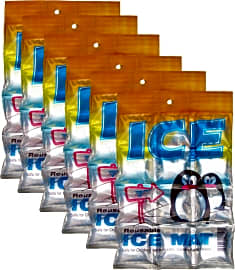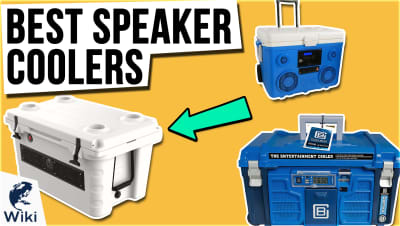The 10 Best Ice Packs for Coolers

This wiki has been updated 37 times since it was first published in February of 2017. When you need to keep items cool for an extended period of time, ice packs offer a more convenient and less messy alternative to wet cubes. We have rated some of the best available to get you through your weekend camping trip, fishing excursion, or all-day sporting event with a chilled beer or fresh sandwich always at hand. You'll find a wide range suitable for various containers. When users buy our independently chosen editorial picks, we may earn commissions to help fund the Wiki.
Editor's Notes
April 13, 2019:
We prioritized price, shape, longevity, portability, and durability when editing this list. You'll find flexible options ideal for manipulating around objects or to soothe injuries, (Icy Cools Penguin, FlexiFreeze Chemical-Free) and thin selections that can slide between items without taking up too much space (Healthy Packers, Fit & Fresh Slim). The Rubbermaid Blue Weekender is a durable option for those who need something reliable on a budget, while the Kleager Cold is great for cans of any size, as well as bottles, small snacks, and food cups. The Cooler Shock nabbed one of our top spots thanks to its fast-acting design and long-lasting low temperature.
Why You Need An Ice Pack For Your Cooler
The mistake we make is in thinking that the cooler can keep cold things cold on its own.
We’ve all, at one time or another, made that fatal error with our coolers that has resulted in a food or drink not being cold enough to really enjoy. The worst of these transgressions usually involves inexpensive beer, which is all but undrinkable when it rises above a certain temperature.
The mistake we make is in thinking that the cooler can keep cold things cold on its own. It seems like a reasonable assumption at first. A good cooler should lock in the temperature of whatever lives inside it, and if your beer is cold when it goes in, it should still be cold when it comes out a few hours later. The problem with this approach is that temperatures have a tendency to move.
The energy we call warmth just loves to rub itself all over surfaces and mix with air that isn’t as warm. Whenever the seal on your cooler is broken — whether it isn’t fully closed or its zipper leaves a tiny gap — you’re inviting warm air currents into your cooler. The same goes for surfaces. If you set your cooler down on a surface that’s warmer than its interior (hot sand or pavement, for example) the cooler’s insulation can only do so much to keep that heat out.
The result is undrinkable beer and potentially dangerous foods. Your refrigerator keeps things cold, but not quite frozen. You can set its internal temperature, but most fridges effectively store food and drink at around 35-37 degrees Fahrenheit. Food becomes susceptible to bacteria and toxins at any temperature above 40 degrees. That means it only takes a short while for foods taken out of the fridge and placed in a cooler to enter what food safety experts call the danger zone.
Some people try to fix the problem by putting ice in the cooler with whatever food they’ve brought along. While that will often solve the problem, it will do so by creating another: the potential for leaks. Ice melts, and when it does, that water — like the warm currents trying to get into your cooler — wants to find a way out. If Murphy’s law has anything to say about it, that water will eventually find its way out, usually somewhere in your car or home.
Fortunately, there are ice packs for coolers that can make all this agony disappear. These simple devices sit in your freezer, get extraordinarily cold, and fit into your cooler without much impact on its capacity. They’re also often lighter than the ice and water you’d have to tote around if you just threw cubes into the cooler. With an ice pack in your cooler, the internal temperature will consistently remain lower for longer, keeping your food and drink at safe and enjoyable temperatures for the duration of your excursion.
Tips For Getting The Most Out Of Your Ice Pack
Now that you’ve gotten yourself an ice pack or two, you need to know how best to deploy it. Just tossing it in your cooler haphazardly will bring you some benefit, but there are other things you can do to make sure your food stays fresh and delicious.
For starters, make sure the cooler itself is up to snuff. If it doesn’t quite close as well as it used to, if it’s zipper or clasp gets stuck in an open position, or if it seems like its contents get too warm too quickly (even with an ice pack), it’s definitely time to get yourself a new cooler.
The most important thing you can do is master organization.
Once you know your cooler isn’t problematic, you can employ an additional method for optimal cooling. The most important thing you can do is master organization. How you pack your cooler can be a big factor in how cold it stays inside.
Proper packing starts with ice pack placement. If you have a soft-sided cooler, it’d be smart not to place the ice pack on the bottom of the unit, as these styles often have less insulation down below as hard-sided models do. Instead, place your least perishable, least crushable items on the bottom, and your ice pack in the middle. In hard coolers, you should place the ice pack on the bottom, as the biggest source of heat in these is their top seal.
Always place your most perishable items closest to your ice pack. While these packs do lower the overall temperature of a cooler, they will keep the things closest to them the coldest. Any meat or dairy items should take priority here. If you deploy multiple packs, you can utilize one for safety and another for enjoyment (making sure the beer stays cold).
Finally, make sure you double check the manufacturer’s recommended fill line inside your cooler. Often, especially in hard-sided coolers, there’s a visible marking above which you shouldn’t pack any food or drinks that could spoil easily, as this is where the warmest air inside the cooler is going to reside.
A Brief History Of Cold Preservation
In certain climates, there isn’t much of a need for external apparatuses to keep things cold. If there’s snow on the ground, there’s a good chance that your food is going to stay frosty. As far back as we have evidence, however, humans have needed to preserve food, and keeping it cold sometimes required ingenuity.
In certain climates, there isn’t much of a need for external apparatuses to keep things cold.
Some of the first attempts to keep food cold involved storing it underground. Our ancestors dug holes and built cellars explicitly for this purpose. In some cases, this storage method failed, but produced edible results, like kimchi, which is traditionally fermented underground.
In the 1800s, an ice trade began to boom, allowing people to purchase ice harvested from northern climates. Deliverymen brought large blocks of ice around to communities where they could cut them down to any size their customers required.
The last means by which we kept food cold before the refrigerator came along was known as the icebox. This household device worked like a large, hard-sided cooler, but looked more like the refrigerators of the 1950s and 1960s. Ice blocks fit into a bottom compartment, and kept the box’s contents cold.















